Employee Motivation: Factors, Experiences, and Strategies for Growth
VerifiedAdded on 2023/06/18
|7
|1897
|88
Report
AI Summary
This report examines the multifaceted nature of employee motivation, beginning with a definition of motivation and an overview of Maslow's hierarchy of needs. It identifies key factors such as salary, promotion opportunities, and work environment that significantly influence employee performance. The report further delves into the positive aspects experienced by employees, including growth opportunities, fair policies, and a supportive working culture, alongside negative components like poor management, unhealthy environments, and workplace conflicts. Strategies to mitigate these negative factors are discussed, emphasizing the importance of reducing pressure, providing recognition, and fostering a healthy work environment. The conclusion reiterates the significance of financial stability and improved living standards as primary motivators, highlighting the role of various factors in engaging employees and enhancing operational efficiency.

Understanding why
people work
people work
Paraphrase This Document
Need a fresh take? Get an instant paraphrase of this document with our AI Paraphraser
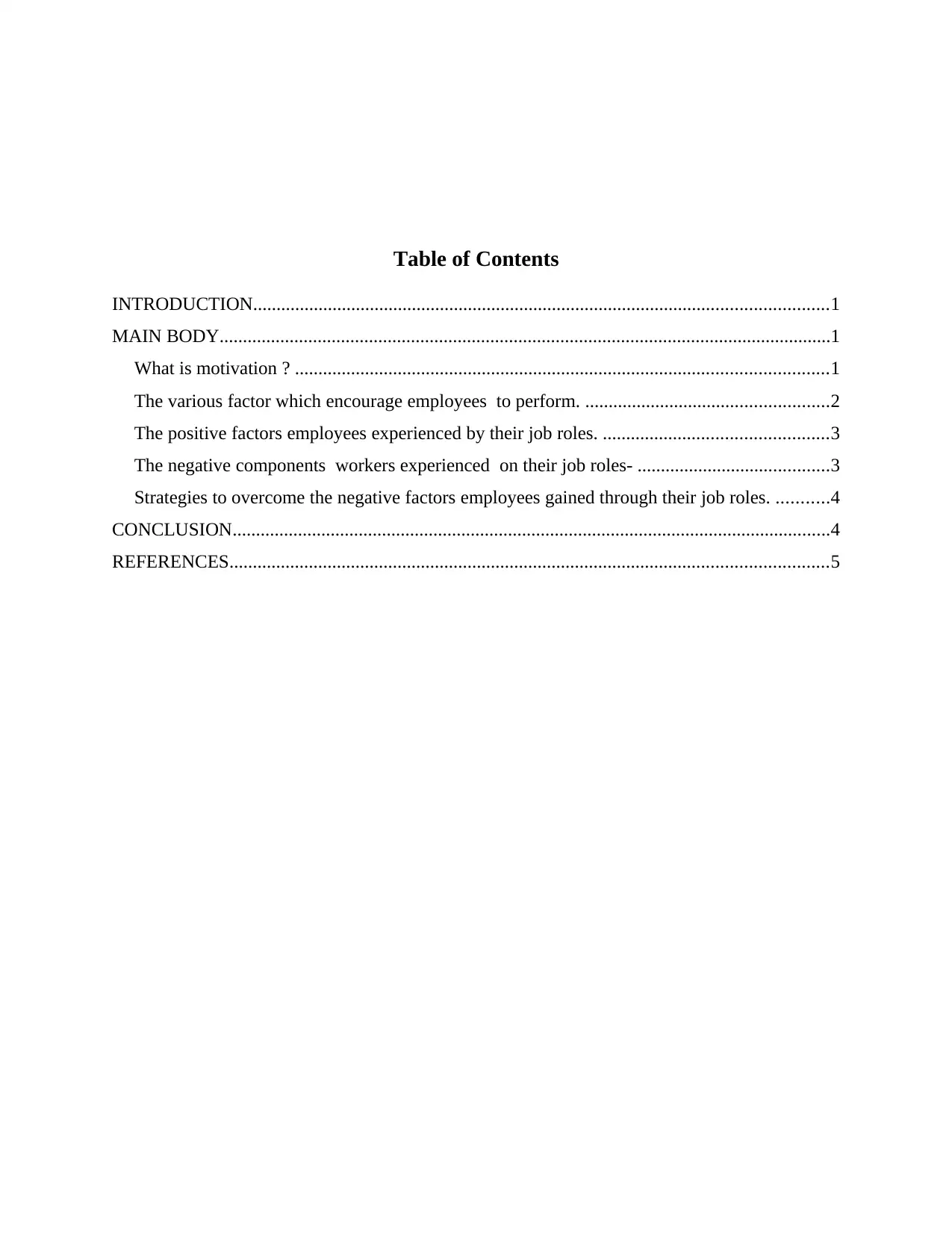
Table of Contents
INTRODUCTION...........................................................................................................................1
MAIN BODY...................................................................................................................................1
What is motivation ? ..................................................................................................................1
The various factor which encourage employees to perform. ....................................................2
The positive factors employees experienced by their job roles. ................................................3
The negative components workers experienced on their job roles- .........................................3
Strategies to overcome the negative factors employees gained through their job roles. ...........4
CONCLUSION................................................................................................................................4
REFERENCES................................................................................................................................5
INTRODUCTION...........................................................................................................................1
MAIN BODY...................................................................................................................................1
What is motivation ? ..................................................................................................................1
The various factor which encourage employees to perform. ....................................................2
The positive factors employees experienced by their job roles. ................................................3
The negative components workers experienced on their job roles- .........................................3
Strategies to overcome the negative factors employees gained through their job roles. ...........4
CONCLUSION................................................................................................................................4
REFERENCES................................................................................................................................5
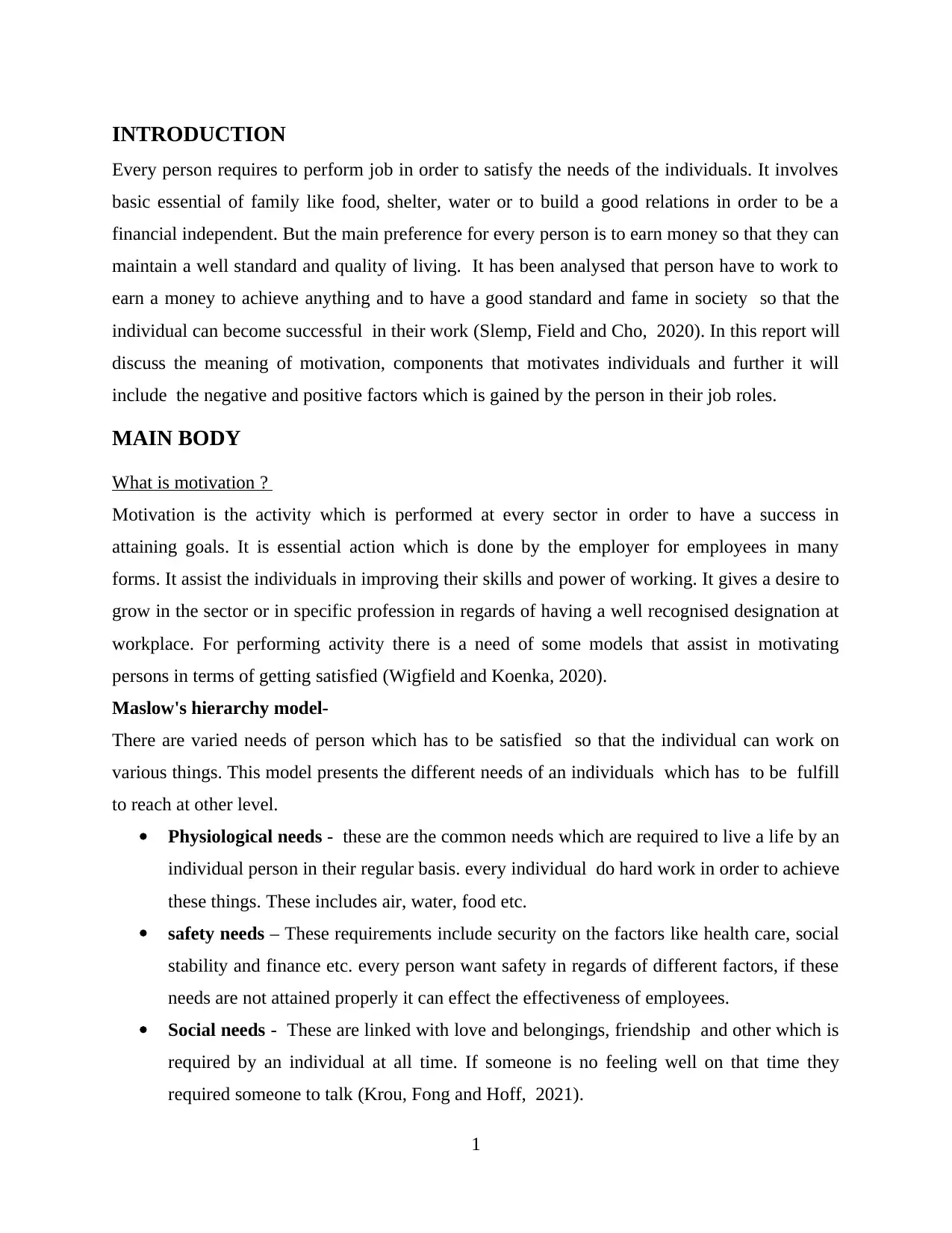
INTRODUCTION
Every person requires to perform job in order to satisfy the needs of the individuals. It involves
basic essential of family like food, shelter, water or to build a good relations in order to be a
financial independent. But the main preference for every person is to earn money so that they can
maintain a well standard and quality of living. It has been analysed that person have to work to
earn a money to achieve anything and to have a good standard and fame in society so that the
individual can become successful in their work (Slemp, Field and Cho, 2020). In this report will
discuss the meaning of motivation, components that motivates individuals and further it will
include the negative and positive factors which is gained by the person in their job roles.
MAIN BODY
What is motivation ?
Motivation is the activity which is performed at every sector in order to have a success in
attaining goals. It is essential action which is done by the employer for employees in many
forms. It assist the individuals in improving their skills and power of working. It gives a desire to
grow in the sector or in specific profession in regards of having a well recognised designation at
workplace. For performing activity there is a need of some models that assist in motivating
persons in terms of getting satisfied (Wigfield and Koenka, 2020).
Maslow's hierarchy model-
There are varied needs of person which has to be satisfied so that the individual can work on
various things. This model presents the different needs of an individuals which has to be fulfill
to reach at other level.
Physiological needs - these are the common needs which are required to live a life by an
individual person in their regular basis. every individual do hard work in order to achieve
these things. These includes air, water, food etc.
safety needs – These requirements include security on the factors like health care, social
stability and finance etc. every person want safety in regards of different factors, if these
needs are not attained properly it can effect the effectiveness of employees.
Social needs - These are linked with love and belongings, friendship and other which is
required by an individual at all time. If someone is no feeling well on that time they
required someone to talk (Krou, Fong and Hoff, 2021).
1
Every person requires to perform job in order to satisfy the needs of the individuals. It involves
basic essential of family like food, shelter, water or to build a good relations in order to be a
financial independent. But the main preference for every person is to earn money so that they can
maintain a well standard and quality of living. It has been analysed that person have to work to
earn a money to achieve anything and to have a good standard and fame in society so that the
individual can become successful in their work (Slemp, Field and Cho, 2020). In this report will
discuss the meaning of motivation, components that motivates individuals and further it will
include the negative and positive factors which is gained by the person in their job roles.
MAIN BODY
What is motivation ?
Motivation is the activity which is performed at every sector in order to have a success in
attaining goals. It is essential action which is done by the employer for employees in many
forms. It assist the individuals in improving their skills and power of working. It gives a desire to
grow in the sector or in specific profession in regards of having a well recognised designation at
workplace. For performing activity there is a need of some models that assist in motivating
persons in terms of getting satisfied (Wigfield and Koenka, 2020).
Maslow's hierarchy model-
There are varied needs of person which has to be satisfied so that the individual can work on
various things. This model presents the different needs of an individuals which has to be fulfill
to reach at other level.
Physiological needs - these are the common needs which are required to live a life by an
individual person in their regular basis. every individual do hard work in order to achieve
these things. These includes air, water, food etc.
safety needs – These requirements include security on the factors like health care, social
stability and finance etc. every person want safety in regards of different factors, if these
needs are not attained properly it can effect the effectiveness of employees.
Social needs - These are linked with love and belongings, friendship and other which is
required by an individual at all time. If someone is no feeling well on that time they
required someone to talk (Krou, Fong and Hoff, 2021).
1
⊘ This is a preview!⊘
Do you want full access?
Subscribe today to unlock all pages.

Trusted by 1+ million students worldwide
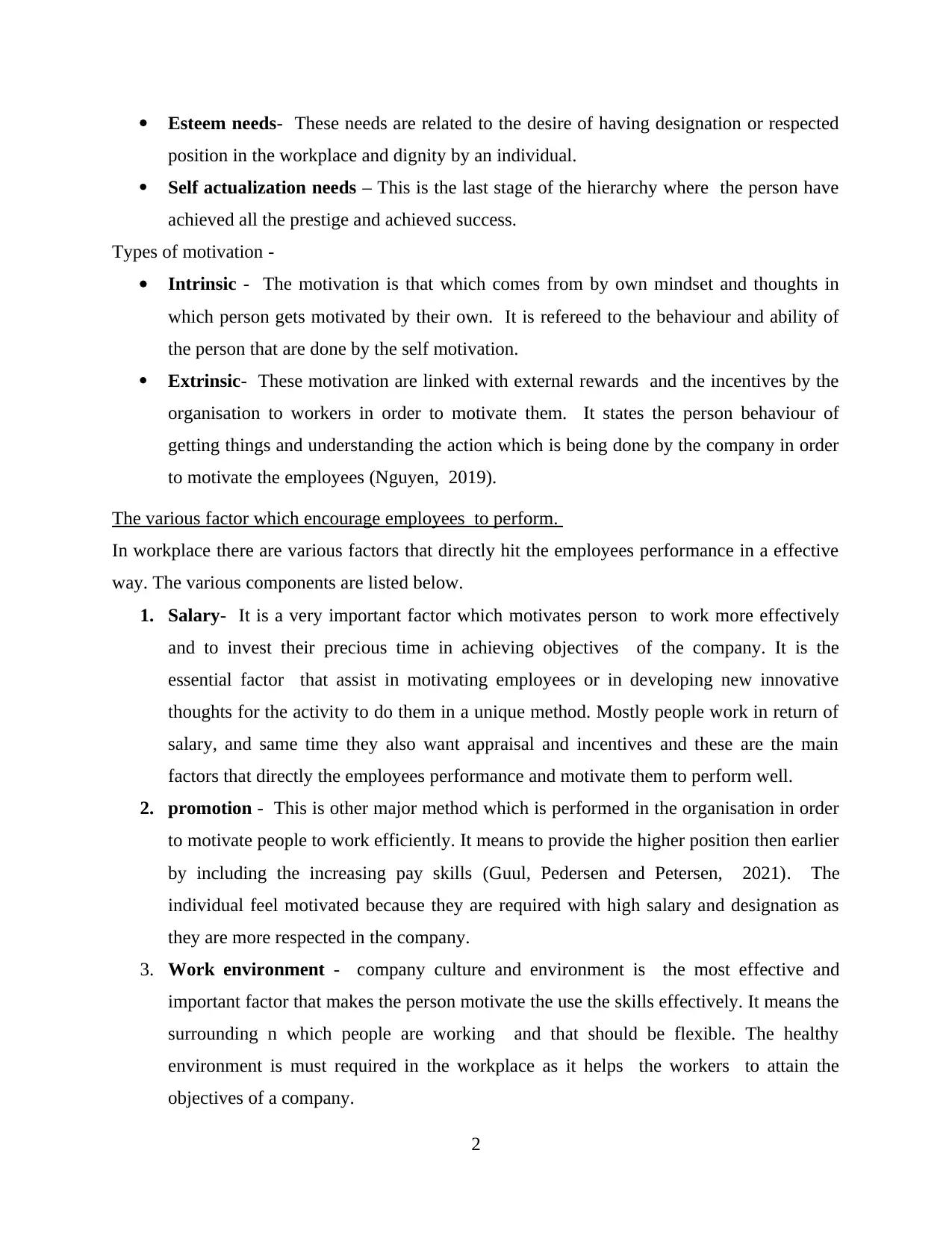
Esteem needs- These needs are related to the desire of having designation or respected
position in the workplace and dignity by an individual.
Self actualization needs – This is the last stage of the hierarchy where the person have
achieved all the prestige and achieved success.
Types of motivation -
Intrinsic - The motivation is that which comes from by own mindset and thoughts in
which person gets motivated by their own. It is refereed to the behaviour and ability of
the person that are done by the self motivation.
Extrinsic- These motivation are linked with external rewards and the incentives by the
organisation to workers in order to motivate them. It states the person behaviour of
getting things and understanding the action which is being done by the company in order
to motivate the employees (Nguyen, 2019).
The various factor which encourage employees to perform.
In workplace there are various factors that directly hit the employees performance in a effective
way. The various components are listed below.
1. Salary- It is a very important factor which motivates person to work more effectively
and to invest their precious time in achieving objectives of the company. It is the
essential factor that assist in motivating employees or in developing new innovative
thoughts for the activity to do them in a unique method. Mostly people work in return of
salary, and same time they also want appraisal and incentives and these are the main
factors that directly the employees performance and motivate them to perform well.
2. promotion - This is other major method which is performed in the organisation in order
to motivate people to work efficiently. It means to provide the higher position then earlier
by including the increasing pay skills (Guul, Pedersen and Petersen, 2021). The
individual feel motivated because they are required with high salary and designation as
they are more respected in the company.
3. Work environment - company culture and environment is the most effective and
important factor that makes the person motivate the use the skills effectively. It means the
surrounding n which people are working and that should be flexible. The healthy
environment is must required in the workplace as it helps the workers to attain the
objectives of a company.
2
position in the workplace and dignity by an individual.
Self actualization needs – This is the last stage of the hierarchy where the person have
achieved all the prestige and achieved success.
Types of motivation -
Intrinsic - The motivation is that which comes from by own mindset and thoughts in
which person gets motivated by their own. It is refereed to the behaviour and ability of
the person that are done by the self motivation.
Extrinsic- These motivation are linked with external rewards and the incentives by the
organisation to workers in order to motivate them. It states the person behaviour of
getting things and understanding the action which is being done by the company in order
to motivate the employees (Nguyen, 2019).
The various factor which encourage employees to perform.
In workplace there are various factors that directly hit the employees performance in a effective
way. The various components are listed below.
1. Salary- It is a very important factor which motivates person to work more effectively
and to invest their precious time in achieving objectives of the company. It is the
essential factor that assist in motivating employees or in developing new innovative
thoughts for the activity to do them in a unique method. Mostly people work in return of
salary, and same time they also want appraisal and incentives and these are the main
factors that directly the employees performance and motivate them to perform well.
2. promotion - This is other major method which is performed in the organisation in order
to motivate people to work efficiently. It means to provide the higher position then earlier
by including the increasing pay skills (Guul, Pedersen and Petersen, 2021). The
individual feel motivated because they are required with high salary and designation as
they are more respected in the company.
3. Work environment - company culture and environment is the most effective and
important factor that makes the person motivate the use the skills effectively. It means the
surrounding n which people are working and that should be flexible. The healthy
environment is must required in the workplace as it helps the workers to attain the
objectives of a company.
2
Paraphrase This Document
Need a fresh take? Get an instant paraphrase of this document with our AI Paraphraser
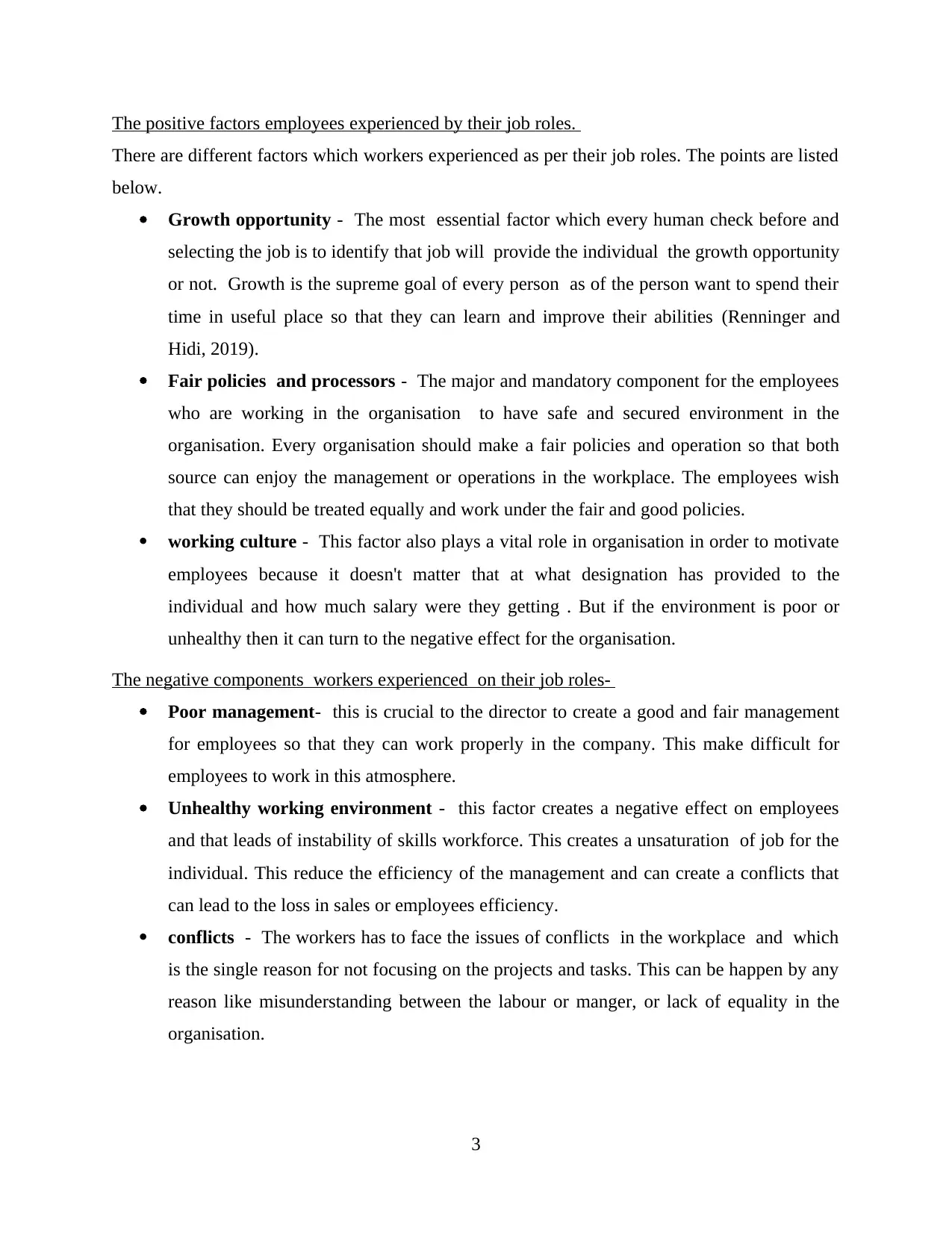
The positive factors employees experienced by their job roles.
There are different factors which workers experienced as per their job roles. The points are listed
below.
Growth opportunity - The most essential factor which every human check before and
selecting the job is to identify that job will provide the individual the growth opportunity
or not. Growth is the supreme goal of every person as of the person want to spend their
time in useful place so that they can learn and improve their abilities (Renninger and
Hidi, 2019).
Fair policies and processors - The major and mandatory component for the employees
who are working in the organisation to have safe and secured environment in the
organisation. Every organisation should make a fair policies and operation so that both
source can enjoy the management or operations in the workplace. The employees wish
that they should be treated equally and work under the fair and good policies.
working culture - This factor also plays a vital role in organisation in order to motivate
employees because it doesn't matter that at what designation has provided to the
individual and how much salary were they getting . But if the environment is poor or
unhealthy then it can turn to the negative effect for the organisation.
The negative components workers experienced on their job roles-
Poor management- this is crucial to the director to create a good and fair management
for employees so that they can work properly in the company. This make difficult for
employees to work in this atmosphere.
Unhealthy working environment - this factor creates a negative effect on employees
and that leads of instability of skills workforce. This creates a unsaturation of job for the
individual. This reduce the efficiency of the management and can create a conflicts that
can lead to the loss in sales or employees efficiency.
conflicts - The workers has to face the issues of conflicts in the workplace and which
is the single reason for not focusing on the projects and tasks. This can be happen by any
reason like misunderstanding between the labour or manger, or lack of equality in the
organisation.
3
There are different factors which workers experienced as per their job roles. The points are listed
below.
Growth opportunity - The most essential factor which every human check before and
selecting the job is to identify that job will provide the individual the growth opportunity
or not. Growth is the supreme goal of every person as of the person want to spend their
time in useful place so that they can learn and improve their abilities (Renninger and
Hidi, 2019).
Fair policies and processors - The major and mandatory component for the employees
who are working in the organisation to have safe and secured environment in the
organisation. Every organisation should make a fair policies and operation so that both
source can enjoy the management or operations in the workplace. The employees wish
that they should be treated equally and work under the fair and good policies.
working culture - This factor also plays a vital role in organisation in order to motivate
employees because it doesn't matter that at what designation has provided to the
individual and how much salary were they getting . But if the environment is poor or
unhealthy then it can turn to the negative effect for the organisation.
The negative components workers experienced on their job roles-
Poor management- this is crucial to the director to create a good and fair management
for employees so that they can work properly in the company. This make difficult for
employees to work in this atmosphere.
Unhealthy working environment - this factor creates a negative effect on employees
and that leads of instability of skills workforce. This creates a unsaturation of job for the
individual. This reduce the efficiency of the management and can create a conflicts that
can lead to the loss in sales or employees efficiency.
conflicts - The workers has to face the issues of conflicts in the workplace and which
is the single reason for not focusing on the projects and tasks. This can be happen by any
reason like misunderstanding between the labour or manger, or lack of equality in the
organisation.
3
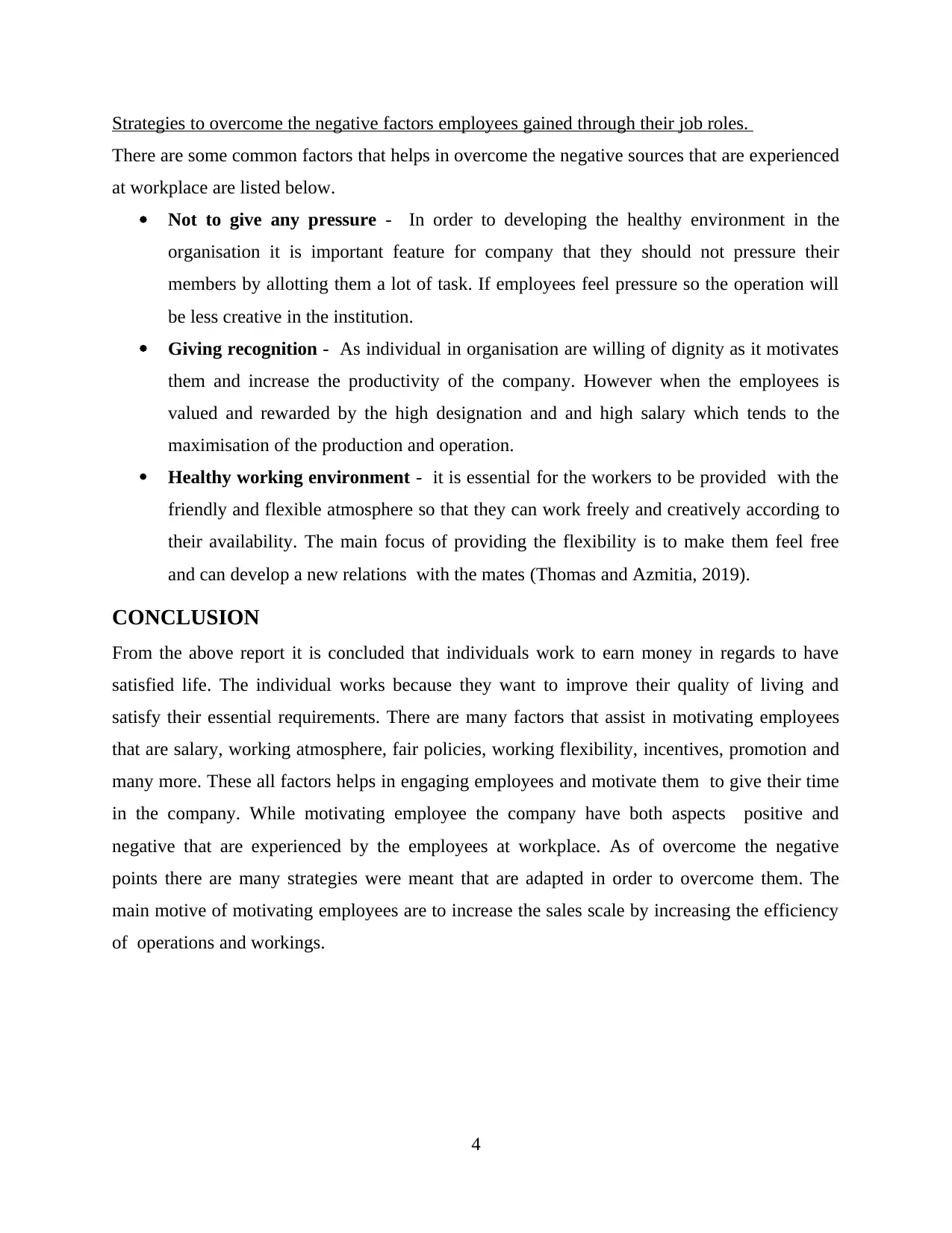
Strategies to overcome the negative factors employees gained through their job roles.
There are some common factors that helps in overcome the negative sources that are experienced
at workplace are listed below.
Not to give any pressure - In order to developing the healthy environment in the
organisation it is important feature for company that they should not pressure their
members by allotting them a lot of task. If employees feel pressure so the operation will
be less creative in the institution.
Giving recognition - As individual in organisation are willing of dignity as it motivates
them and increase the productivity of the company. However when the employees is
valued and rewarded by the high designation and and high salary which tends to the
maximisation of the production and operation.
Healthy working environment - it is essential for the workers to be provided with the
friendly and flexible atmosphere so that they can work freely and creatively according to
their availability. The main focus of providing the flexibility is to make them feel free
and can develop a new relations with the mates (Thomas and Azmitia, 2019).
CONCLUSION
From the above report it is concluded that individuals work to earn money in regards to have
satisfied life. The individual works because they want to improve their quality of living and
satisfy their essential requirements. There are many factors that assist in motivating employees
that are salary, working atmosphere, fair policies, working flexibility, incentives, promotion and
many more. These all factors helps in engaging employees and motivate them to give their time
in the company. While motivating employee the company have both aspects positive and
negative that are experienced by the employees at workplace. As of overcome the negative
points there are many strategies were meant that are adapted in order to overcome them. The
main motive of motivating employees are to increase the sales scale by increasing the efficiency
of operations and workings.
4
There are some common factors that helps in overcome the negative sources that are experienced
at workplace are listed below.
Not to give any pressure - In order to developing the healthy environment in the
organisation it is important feature for company that they should not pressure their
members by allotting them a lot of task. If employees feel pressure so the operation will
be less creative in the institution.
Giving recognition - As individual in organisation are willing of dignity as it motivates
them and increase the productivity of the company. However when the employees is
valued and rewarded by the high designation and and high salary which tends to the
maximisation of the production and operation.
Healthy working environment - it is essential for the workers to be provided with the
friendly and flexible atmosphere so that they can work freely and creatively according to
their availability. The main focus of providing the flexibility is to make them feel free
and can develop a new relations with the mates (Thomas and Azmitia, 2019).
CONCLUSION
From the above report it is concluded that individuals work to earn money in regards to have
satisfied life. The individual works because they want to improve their quality of living and
satisfy their essential requirements. There are many factors that assist in motivating employees
that are salary, working atmosphere, fair policies, working flexibility, incentives, promotion and
many more. These all factors helps in engaging employees and motivate them to give their time
in the company. While motivating employee the company have both aspects positive and
negative that are experienced by the employees at workplace. As of overcome the negative
points there are many strategies were meant that are adapted in order to overcome them. The
main motive of motivating employees are to increase the sales scale by increasing the efficiency
of operations and workings.
4
⊘ This is a preview!⊘
Do you want full access?
Subscribe today to unlock all pages.

Trusted by 1+ million students worldwide
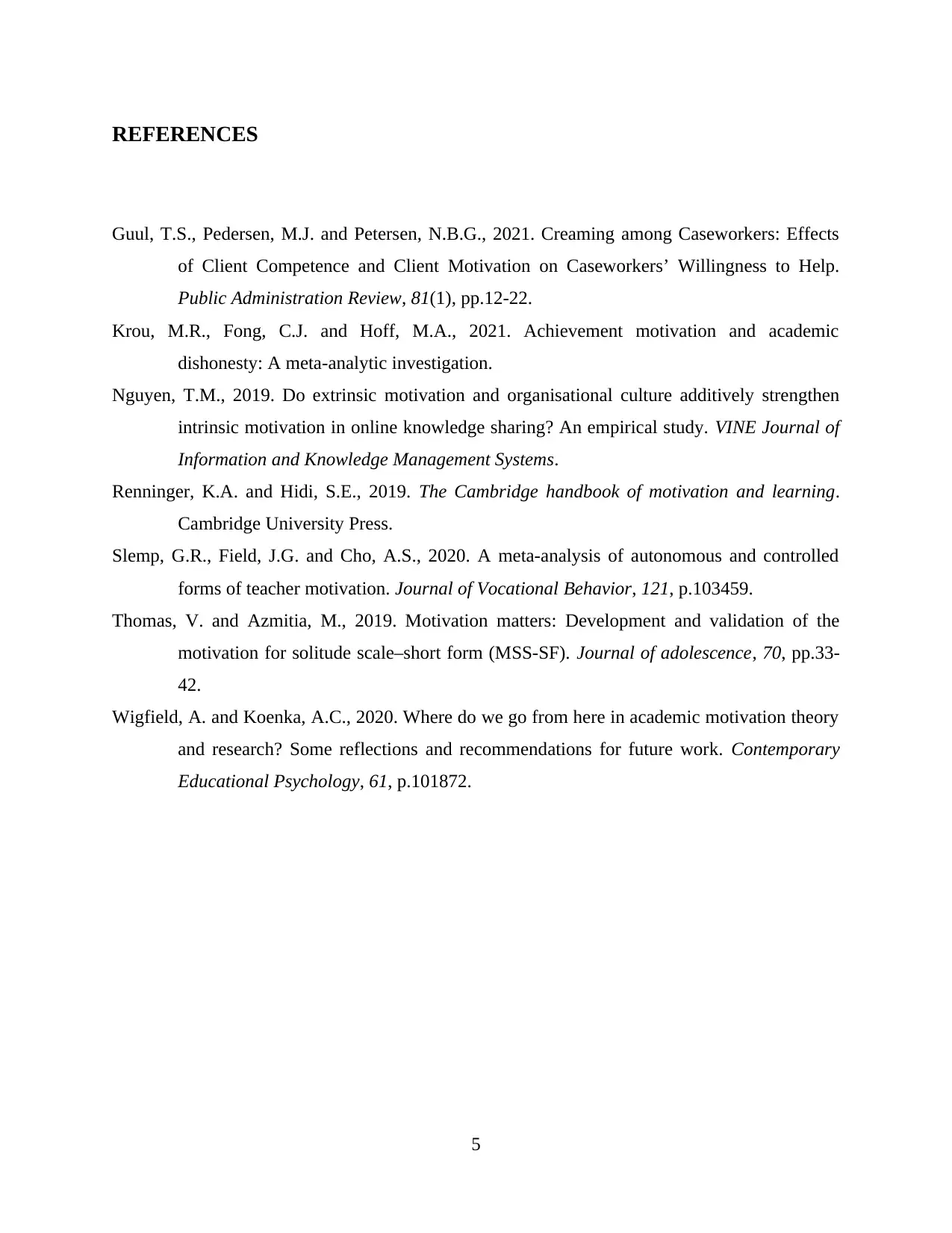
REFERENCES
Guul, T.S., Pedersen, M.J. and Petersen, N.B.G., 2021. Creaming among Caseworkers: Effects
of Client Competence and Client Motivation on Caseworkers’ Willingness to Help.
Public Administration Review, 81(1), pp.12-22.
Krou, M.R., Fong, C.J. and Hoff, M.A., 2021. Achievement motivation and academic
dishonesty: A meta-analytic investigation.
Nguyen, T.M., 2019. Do extrinsic motivation and organisational culture additively strengthen
intrinsic motivation in online knowledge sharing? An empirical study. VINE Journal of
Information and Knowledge Management Systems.
Renninger, K.A. and Hidi, S.E., 2019. The Cambridge handbook of motivation and learning.
Cambridge University Press.
Slemp, G.R., Field, J.G. and Cho, A.S., 2020. A meta-analysis of autonomous and controlled
forms of teacher motivation. Journal of Vocational Behavior, 121, p.103459.
Thomas, V. and Azmitia, M., 2019. Motivation matters: Development and validation of the
motivation for solitude scale–short form (MSS-SF). Journal of adolescence, 70, pp.33-
42.
Wigfield, A. and Koenka, A.C., 2020. Where do we go from here in academic motivation theory
and research? Some reflections and recommendations for future work. Contemporary
Educational Psychology, 61, p.101872.
5
Guul, T.S., Pedersen, M.J. and Petersen, N.B.G., 2021. Creaming among Caseworkers: Effects
of Client Competence and Client Motivation on Caseworkers’ Willingness to Help.
Public Administration Review, 81(1), pp.12-22.
Krou, M.R., Fong, C.J. and Hoff, M.A., 2021. Achievement motivation and academic
dishonesty: A meta-analytic investigation.
Nguyen, T.M., 2019. Do extrinsic motivation and organisational culture additively strengthen
intrinsic motivation in online knowledge sharing? An empirical study. VINE Journal of
Information and Knowledge Management Systems.
Renninger, K.A. and Hidi, S.E., 2019. The Cambridge handbook of motivation and learning.
Cambridge University Press.
Slemp, G.R., Field, J.G. and Cho, A.S., 2020. A meta-analysis of autonomous and controlled
forms of teacher motivation. Journal of Vocational Behavior, 121, p.103459.
Thomas, V. and Azmitia, M., 2019. Motivation matters: Development and validation of the
motivation for solitude scale–short form (MSS-SF). Journal of adolescence, 70, pp.33-
42.
Wigfield, A. and Koenka, A.C., 2020. Where do we go from here in academic motivation theory
and research? Some reflections and recommendations for future work. Contemporary
Educational Psychology, 61, p.101872.
5
1 out of 7
Related Documents
Your All-in-One AI-Powered Toolkit for Academic Success.
+13062052269
info@desklib.com
Available 24*7 on WhatsApp / Email
![[object Object]](/_next/static/media/star-bottom.7253800d.svg)
Unlock your academic potential
Copyright © 2020–2025 A2Z Services. All Rights Reserved. Developed and managed by ZUCOL.

